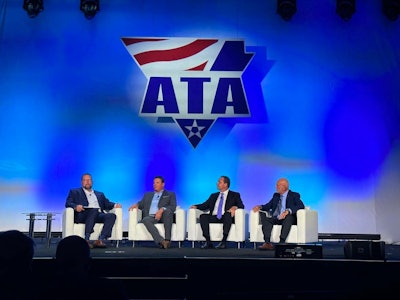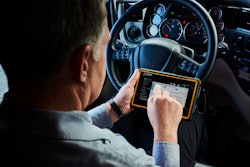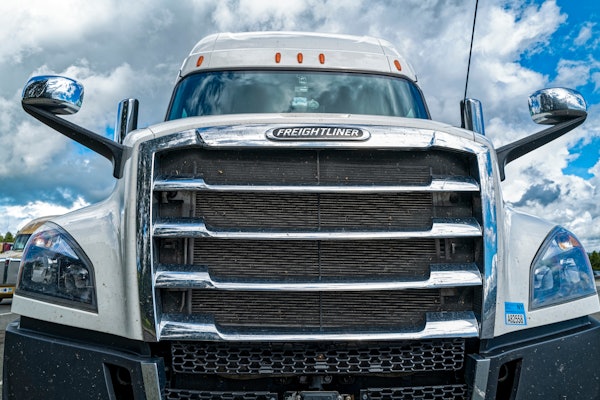
Workforce development, the environment, infrastructure and the supply chain – those were highlights of the conversation on the state of trucking in North America and around the world at the American Trucking Associations Management Conference & Exhibition in San Diego.
The panel included representatives in the industry from the U.S., Canada, Mexico and Europe, who discussed how each stack up when it comes to these issues, and they found that everyone is facing the same challenges.
The driver shortage
Workforce development took the lead with the driver shortage being a top concern.
Register today for "2023 Outlook for Trucking" webinar
Economists and industry experts discuss the market forces, business conditions and supply chain issues that will impact carrier operations in 2023. This complimentary CCJ webinar is sponsored by Bestpass. This CCJ webinar is sponsored by Bestpass.
Canada’s trucking industry is about one-tenth the scale of the U.S.’s trucking industry, and it is 28,000 drivers short today with an estimated 55,000 short by the end of 2024 due to retirements, among other things, said Rob Penner, CEO of Bison Transport (CCJ Top 250, No. 50), one of Canada’s largest trucking companies.
Radu Dinescu, president of IRU, said the organization identified the top three countries with the worst shortages are Ukraine, Turkey and Pakistan because the majority of drivers are working in western countries like France and Germany. Mexico was also on the list; Mexico is short 54,000 drivers, said Ramon Madrano Ibarra, presidente nacional at Canacar, the Mexican equivalent of ATA.
“We don't have as many women drivers as we would like to have. On the highway, you can count the women on your fingers. Why is that? Because we haven’t been able to give the male drivers proper life quality,” Ibarra said. “So we need to work for the drivers, and we are going to do that until my last day in this organization.”
Much like the U.S, the IRU is focusing on driver pay, secure parking places, better conditions when crossing borders, automation technology and the image of the professional driver to improve the issue, Dinescu said.
The U.S. is also working to lower the driver age and recruit more women to help solve the shortage, but Derek Leathers, chair, president and CEO at Werner Enterprises (No. 13), said those solutions will not solve the problem entirely.
“The takeaway is, it's not a country issue; it's not a geography issue; it's not a particular part of the industry issue. Whether we like it or not, it's a job issue,” Leathers said. “It's the type of work itself, and we've got to continue to find ways to make the work more rewarding to give people a clearer line of sight to a career path … We have a long way to go to get that message out and make that message clear.”
He said a bizarre silver lining to COVID is that it elevated the image of the professional driver, but it's incumbent on industry leaders to carry that forward and not let it fade away as it sinks farther back in people's memories.
The supply chain issue
The pandemic also exposed some very fragile parts of the supply chain, but Leathers said there’s a positive takeaway from that too.
“We’ve been able to gain visibility; the question is what do you do with it,” he said. “Now that you have visibility, how do we make sure it serves the creed, if you will, that we are what keeps this world economy moving?”
In the U.S., issues included – and remain – obtaining parts and trucks as well as the reputation of trucking’s customers who suffered from it when the end consumer didn’t receive products on time. In Mexico, Ibarra said the issue is administration and the lack of a uniform system at all of the borders.
He said it is important to remember that the final cost goes to the customer, and things need to be more efficient in order to keep costs controlled.
“We often get so exited about some new, big program that’s going to take two years to implement and massive investment on the part of shippers and truckers when instead … you could just do what you’re doing today but do it more efficiently,” Leathers said. “We can’t forget some of those simple solutions that need to be addressed, and we have to continue to keep pressure on them.”
Rob said in the fight to eliminate large inefficiencies, collaboration among nations is important, but we can’t agree on a goal or solution and get attached to archaic rulings that make no sense.
“All of our trucks that are crossing the border, the estimation is they lose three days of productivity a month waiting to either live load or live unload because we aren’t allowed to reposition an empty trailer directly; there’s an assumption that we’re taking away a job so INS says you can’t do that,” Penner said. “We don’t hire anybody to do those things; we just deliver a very inefficient supply chain, and when they talk again about carbon reduction, our fuel burned on that inefficient move alone, they say we’re contributing 18 million kilograms of greenhouse gas wasting time.”
The environmental picture
Penner said the right approach is determining appropriate targets together and then letting the industry figure out how to get there.
But Leathers said the cart is getting ahead of the horse.
“We know that the U.S. OEMs and fleets are facing increasing pressures and regulations all the time to decarbonize, and while we'll applaud that and the position of the ATA and the position of Werner to do everything we can to lower our environmental footprint, we can't let the rhetoric get out in front of the reality,” Leathers said.
That has not been the path the government has taken, Penner said.
He said the government has rolled out a carbon tax that takes hundreds of millions of dollars away from the industry while paying back only tens of millions.
The biggest problem, he said, is there’s no strategy.
Dinescu said the IRU has established the Green Compact to achieve carbon neutrality in commercial road transport services by 2050. It includes multiple elements that can contribute to the goal.
While more is being discovered regarding biofuels, natural gas, hydrogen and electric, he said there are some things that can be done in the short term to help like carrying more goods per trailer, aerodynamics, tires and driver training.
“There is a potential to use existing technologies in order to make some quick steps toward decarbonization,” he said.
Ibarra said Mexico is having to turn to the basics because it does not have the latest technology engines nor the fiscal incentives to invest in green technologies. Mexico’s main goal right now, he said, is to renew its fleets, but there are zero incentives for that either. Fleets in Mexico are 20 years old, he said.
In the U.S., Leathers said the average age of a fleet is 5.9 years old.
“The single easiest incentive, if you will, to lower your carbon footprint would be to eliminate the excise tax; make it easier for fleets to renovate their fleet, move the MPG of the United States trucking industry from 6.0 to 7.8 or 8.0, and you'll make a larger reduction in carbon footprint than any other initiative underway today,” Leathers said.
He said he applauds the efforts toward electrification, but it’s in response to a regulatory framework that is forcing the industry to pick a solution versus chipping away at it in ways that make sense, like applying them in big city environments where smog and contaminants are at their worst as opposed to across the board.
“We need to address the underlying problem without trying to be prescriptive in how we solve it,” he said. “If we could agree as to what the goal is and what we’re trying to accomplish and do a lot of that accomplishment through the elimination of waste that already exists today versus being overly prescriptive and overly rapid in our aggressive approach to implementing new technologies prior to the infrastructure being ready to absorb it, I think we can still get to the same destination and keep America moving every day.”
The infrastructure outlook
Not only is the infrastructure for electric vehicles not widely available, infrastructure in general is suffering.
While the U.S. has a highway trust fund, Leathers said Europe, which does not, has better roads and bridges. Dinescu said that’s because of tolling and restrictions on heavy vehicles in cities, among other things. Ibarra said Mexico has a long way to go and needs more money to invest in highways. But the toll system is incredibly inefficient, creating congested roads. In Canada, all of the road tax goes into a general fund. Penner said the industry has been asking for a separate infrastructure fund for as long as he has been in the industry, but there hasn’t been an appetite for it.
In the U.S., there’s the fuel tax, which Leathers said is an unbelievably efficient collection vehicle. But with electric vehicles, the country is looking to implement a VMT (vehicle miles traveled tax), which Leathers said will raise the cost of overhead with administration fees by 20% to 30%.
“If we’re going to wrap our minds around this environmental footprint and decarbonization and everything else, why take away one of the biggest incentives for more efficient operations and better stewards of fuel than the fuel tax?” Leathers said. “If you’re going to tax me by the mile regardless of my efficiency inside that truck, you’ve taken away a natural incentive that exists today and replaced it with something that doesn’t provide the same.”












